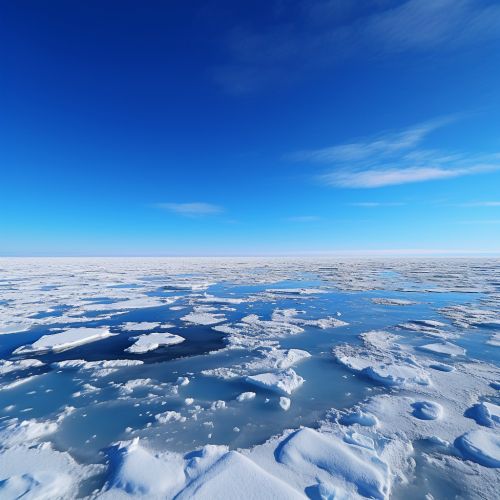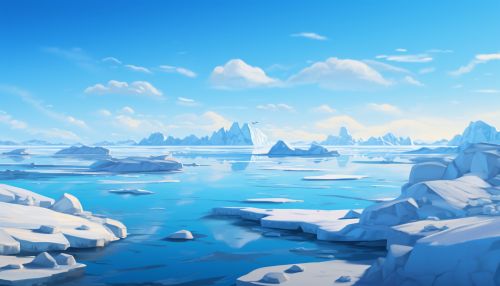Arctic Ocean
Overview
The Arctic Ocean, located in the northernmost part of the Earth, is the smallest and shallowest of the world's five major oceans. It is surrounded by Eurasia, North America, Greenland, and several smaller islands. Despite its small size, the Arctic Ocean plays a significant role in global climate regulation, marine biodiversity, and human activities.
Geography
The Arctic Ocean spans an area of about 14.05 million square kilometers, making it about 1.5 times the size of the United States. It is bordered by the continents of North America and Eurasia, and the countries that have coastlines on the Arctic Ocean include Russia, Norway, Iceland, Greenland (Denmark), Canada, and the United States (Alaska).
The ocean is almost completely surrounded by land, making it the most landlocked of the world's oceans. This geography contributes to its characteristic cold temperatures and heavy ice cover. The Arctic Ocean's average depth is 1,038 meters, with its deepest point, the Eurasian Basin, reaching depths of over 5,450 meters.
Hydrology
The Arctic Ocean's hydrology is complex and influenced by a variety of factors, including its ice cover, inflow from rivers and other oceans, and atmospheric conditions. The ocean's salinity varies widely, from less than 10 parts per thousand (ppt) near the mouths of large rivers to around 35 ppt in the main ocean basins.
The Arctic Ocean is unique among the world's oceans in its extensive cover of sea ice. This ice cover varies seasonally, with the maximum extent typically occurring in March and the minimum in September. The presence of sea ice has a significant impact on the ocean's physical and biological characteristics, including its temperature, salinity, and marine life.
Climate
The Arctic Ocean's climate is characterized by long, extremely cold winters and short, cool summers. The region is known for its harsh conditions, with temperatures often dropping below -40 degrees Celsius in winter. Despite these extreme conditions, the Arctic Ocean plays a crucial role in global climate regulation. It acts as a "sink" for heat and carbon dioxide, helping to moderate global temperatures and climate.
Marine Life
The Arctic Ocean is home to a diverse array of marine life, including numerous species of fish, birds, and mammals. Among the most iconic species are the polar bear, walrus, and various species of seals and whales. The ocean's biological productivity is highly seasonal, with most biological activity occurring during the short summer period when sunlight is available.
Human Activity
Human activity in the Arctic Ocean has increased significantly in recent years, driven by the region's rich natural resources and the opening of new shipping routes due to melting sea ice. Activities such as fishing, shipping, and oil and gas exploration pose significant challenges to the region's environment and indigenous communities.
Environmental Concerns
The Arctic Ocean is facing a range of environmental challenges, most notably climate change. Rising temperatures are causing rapid melting of sea ice, with significant implications for marine life, human activities, and global climate patterns. Other concerns include pollution from shipping and resource extraction activities, overfishing, and the impacts of increased human activity on indigenous communities and wildlife.
See Also


